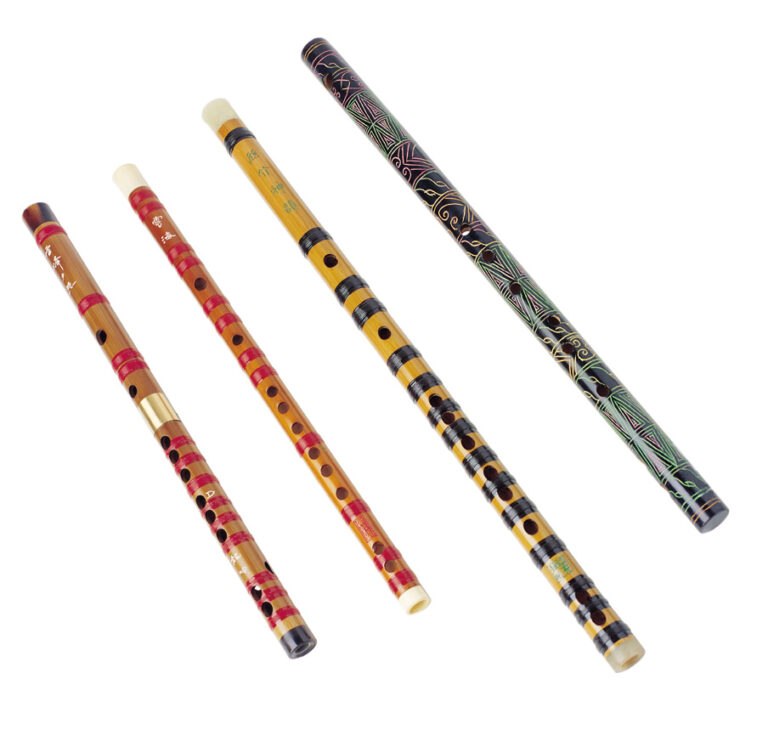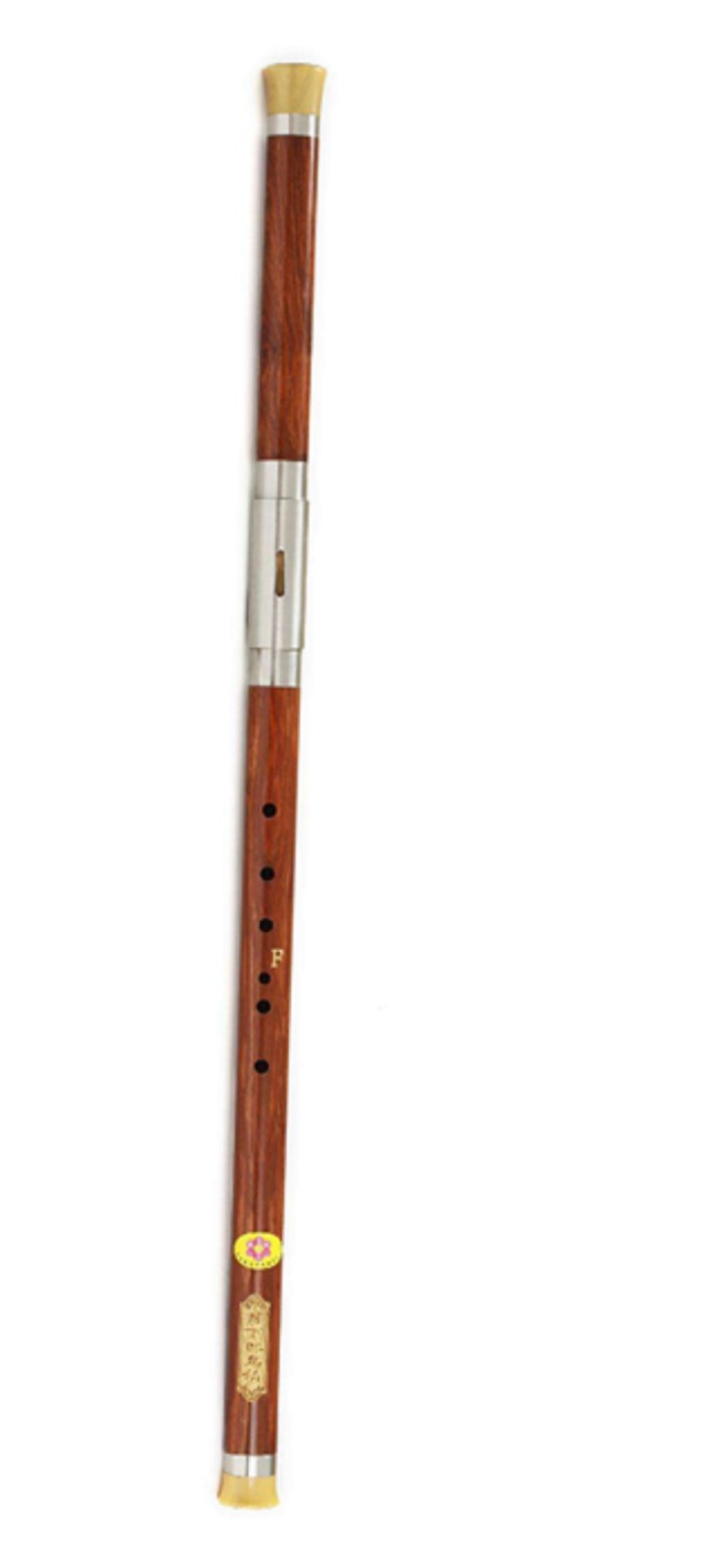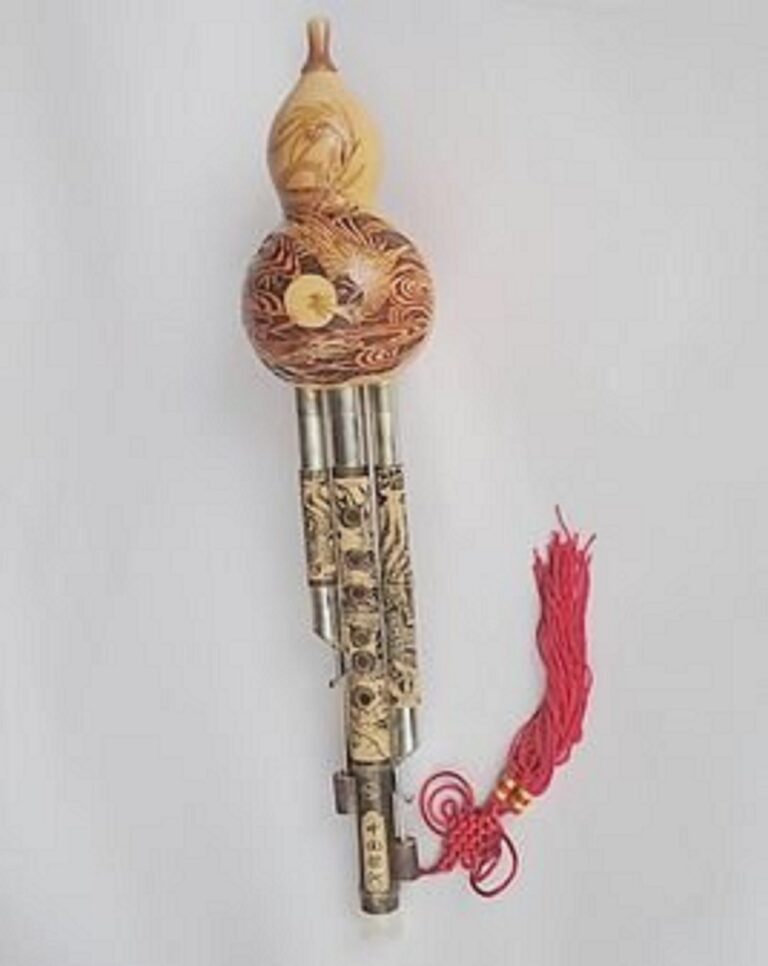中國民族音樂資料館 Chinese Music Archive
吹管類 Other Wind Instruments
笛子 - Dizi
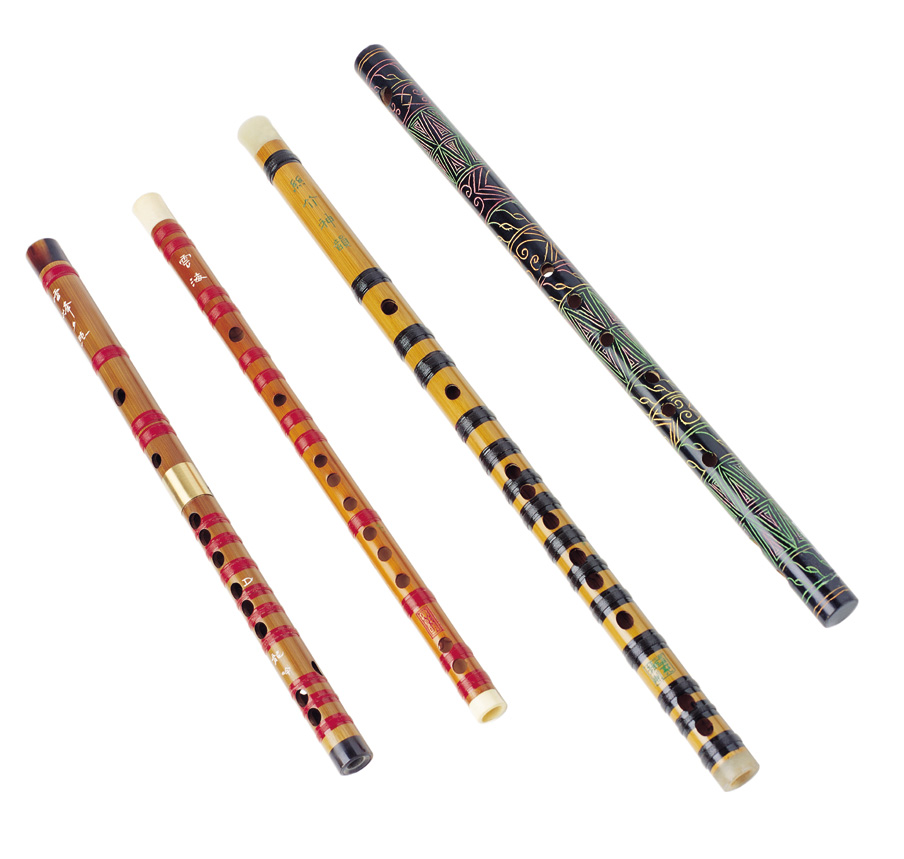
笛子,古代稱為「橫吹」,後來又稱「橫笛」。相傳漢武帝時(公元前一四○至八七年),張騫到了西域(即現在的中亞細亞一帶)以後,才開始將吹笛的方法,傳到當時的首都長安(即現在的西安)。從漢墓的拓片和敦煌的壁畫中都有笛子這一點來看,可以相信,我國至少在二千多年以前就已經有了這樣的樂器。笛子傳入後,人民在長期演奏的實踐過程中,結合了本民族的特點和喜愛,創造性的發展了笛子的演奏技術。如在宋、明之間,民間流行了半孔按法。這種情況,在宋代陳暘《樂書》、明代朱載堉《律呂精義》與朝鮮的《樂學軌範》中,都有詳細的記載。
目前民間各地流行的笛子,種類很多。有伴奏南方昆曲或其他地方戲曲的曲笛;有伴奏北方梆子戲的梆笛;還有民間各地局部流行的笛子。除此以外,在新中國成立後,各文藝工作團體還開始應用了他們試製的各種改良新笛。雖然笛子的種類很多,但在民間較普遍應用的,是曲笛和梆笛兩種。
笛子是一種竹製的樂器,上開有吹孔和膜孔各一,按指孔六個,音色清脆,音域較寬,能吹兩組多一點的音;梆笛比曲笛短小,在音高上,比曲笛高一個純四度。曲笛的音色柔美而清脆,梆笛則高亢而明朗。這二種笛子除伴奏戲曲外,也普遍地應用於獨奏、合奏和民歌、舞蹈的伴奏;伴奏時,它往往以主要樂器的地位出現。
新中國成立後,對笛進行了多次改革,先後製出了成套的十二調的笛,並在曲笛的基礎上改製了加鍵笛,保留原有的六個音孔,用鍵子控制新增的半音,便於臨時升降半音及轉調。
Dizi was called the Horizontal Winds in ancient times. Later on, it was also called the Horizontal Flute. It was told that ZHANG Qian of the Han Emperor Wu (140 to 87 B.C.) firstly brought back the method of performing the dizi from the Western Regions out of China to the capital Chang’an. It was clearly showed that from the rubbings of the ancient tombs and murals of Dunhuang of Han dynasty, dizi was used as musical instrument at least 2,000 years in China. Since that on, Chinese people had made long-term practices on performing which developed most of the performing techniques of dizi. These were reflected in full details on the Book of Music by CHEN Yang of the Song dynasty, the Meaning of Lulu (pitch) by ZHU Zai-yu of the Ming dynasty and the book Trend of Music of the North Korea.
At present, there are different kinds of dizi be used in the Chinese music. The most popular ones are the qudi used in the operatic music of the southern areas, such as Kunqu and the bangdi used in the operatic music of the northern areas, such as Bangzi. There are still other kinds of dizi be used in local music. After the establishment of New China, musicians have made improvements on the traditional dizi and invent some kinds of new ones. Although there are many types, the most popular ones are the qudi and bangdi.
Dizi is made with bamboo and has a range of more than two octaves. Along the bamboo, there are one hole for blowing, one hole for the membrane and six holes for the scale. Bangdi is much smaller and the pitch is higher than that of the qudi. These two kinds of dizi are the main instruments of the ensemble. Besides of opera accompaniment, they are also used as solo instruments and accompaniment for folk songs and dances.
Nowadays, there are new reformations on dizi. In preservation of the traditional six scale holes, there is a mechanic-operated system to be applied for the newly added semitone holes. A complete set of twelve different pitch dizi is manufactured for the use in modern compositions, etc.
笙 - Sheng
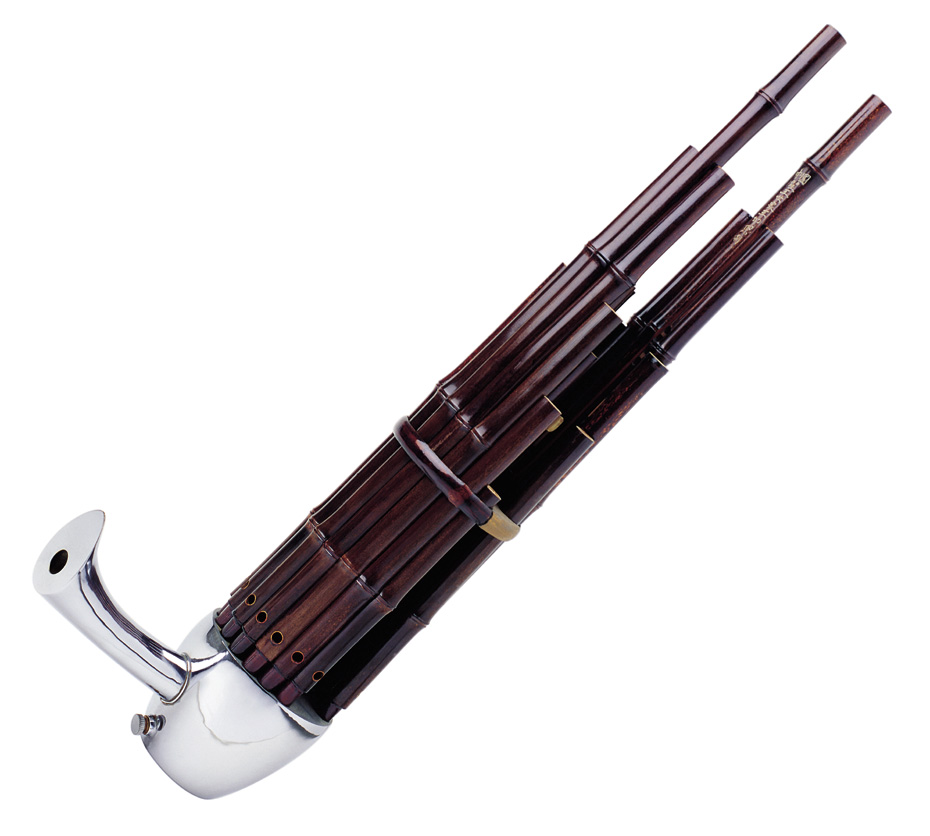
笙,是我國古老的簧管樂器。殷代(公元前一四○一至前一一二二年)的甲骨文中已有「和」(小笙)的名稱。在春秋末期的《詩經》中,也經常提到它。春秋戰國時期,笙是最主要的一種樂器,大的名竽,有三十六簧,早期的簧為竹製,後來改為銅製。長沙馬王堆三號漢墓出土的漢初的竽,有二十六管,簧為竹製。
南北朝到隋唐時期,主要有十九簧、十七簧、十三簧的笙,唐代又有十七簧的義管笙,在十七簧之外,另備兩根義管,需要時,才將它臨時裝上去。北宋景德三年(公元一○○六年),宮廷樂工單仲辛把義管笙恢復為十九簧笙,當時曾普遍應用。
北宋初年(約在公元九六○至九六五年間),四川地區曾出現一種裝有三十六簧的鳳笙,但未流傳開來。
明清時期,民間流行的笙有方、圓、大、小各種不同的類型。有一種能轉四個調的十七簧笙,在個別樂隊中使用,但普遍流行的是十三簧和十四簧笙。
笙的構造是,將銅製的簧片裝在若干竹管下端,這些竹管插在一個匏製、木製或銅製的帶有吹口的斗子上。吹時用指按著竹管下端所開的孔,即能使簧片與管中氣柱發生共鳴而發出樂音。演奏時,除偶然使用單音外,大都用二音、三音或四音配合成和音。
新中國成立後,對笙進行了不斷地改革,已有二十一、二十四、二十五、二十六簧及加鍵笙、帶共鳴筒笙等多種類型的笙出現。近年還試製了一種三十二簧笙。這種笙音域較寬,音量較大,具備十二個半音,轉調方便。
笙的吹奏技術也有較大的發展,除了用於伴奏、合奏以外,已發展為獨奏樂器。
Sheng was China’s oldest wind reed instrument. The small sheng was called he (1401 to 1122 B.C.). Later on, it developed to be the main instrument. The big sheng was called yu and had thirty-six reeds. In the early times, the reeds were made of bamboo, and it was changed to brass in later time. The unearthed yu of Han dynasty had twenty-six bamboo reeds. In Tang dynasty, they were mainly nineteen, seventeen and thirteen reeds. In Sichuen, there appeared a thirty-six reeds sheng in early Song dynasty. It was the thirteen and fourteen ones popularly be used in Ming and Qing dynasty. But there were one which could modulate in four keys and it was used only in special ensemble. The sheng was constructed by installing a number of bamboo tubes with reeds on the end of each tube to the wood or brass container which had a blowing end. The bamboo tubes were tuned in different pitch with a sound hole. By closing of these sound holes through fingering, we can perform melody from it. Nowadays, the sheng has constantly reformed to have twenty-one, twenty-four, twenty-five and twenty-six reeds with key controls. Besides used in accompaniment and orchestral works, sheng has been developed into a solo instrument.
蘆笙 - Lusheng
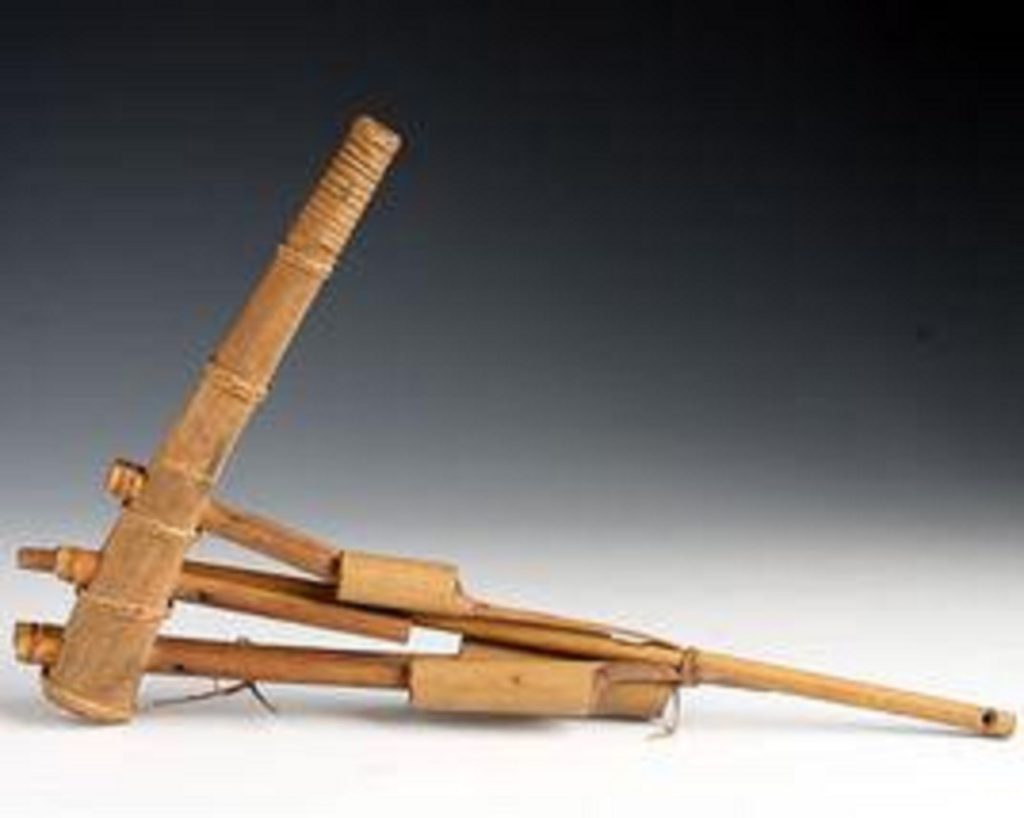
蘆笙,為西南地區苗、瑤、侗等民族的簧管樂器。早在西漢初已出現。南宋范成大《桂海虞衡志》中,曾提到他當時在廣西所見到的瑤族八管蘆笙。
蘆笙大小不一,管的數目也不盡相同,單管、雙管以至五管、六管、八管、十管都有,但較常用的是六管蘆笙。六管蘆笙是用六根長短不一的竹管,分成兩排插入木製的笙斗中;每管的根部各裝一個銅質簧片;管的下端各開一個小孔,吹奏時手指按孔發音。有的蘆笙,在竹管上端套上竹篾折成的三角形喇叭或套上稍大的竹筒,起共鳴作用。吹奏時,以單音奏旋律,同時發出兩個以上的和音作伴奏。
蘆笙多用於獨奏、合奏和舞蹈伴奏。貴州苗族地區,有大小不同的四種蘆笙組成的樂隊,並且有一整套傳統的蘆笙曲。
新中國成立後,對蘆笙進行了多次改革,先後有十五管、二十管、二十六管、三十六管的蘆笙出現。有的將木製笙斗改為金屬笙斗,有的加上音鍵,擴大了音域,能吹奏十二個半音,解決了轉調的問題,能演奏較複雜的樂曲。
Lusheng was the wind reed instrument of Miao, Yao and Dong region of the south-west China. It was said to be appeared in Han dynasty. FAN Cheng-da of the Song dynasty mentioned in his book that he had seen an eight-tube lusheng of Yao tribe. The size and the number of tubes of lusheng are different. There are usually single, double, five, six, eight and ten tubes instruments and the most popular is the six-tube one. It is to use six tubes of different length inserted in two rows into a wooden container. The tubes are installed with brass reeds at the end tuning at different pitch with small holes. By pressing these holes to produce musical sounds. It can play single sound and also cords. It is used for the solo, ensemble and dance accompaniment. At the Miao region of Guizhou, there are ensembles of lushengs with four different sizes and they have their complete set of traditional music. Nowadays, lusheng has been steadily reformed for many times. It has modified to consist of fifteen, twenty, twenty-six and thirty-six tubes instruments. The wooden container has changed to metallic. The scale is upgraded to have twelve semitones and can play more complex music.
簫 - Xiao
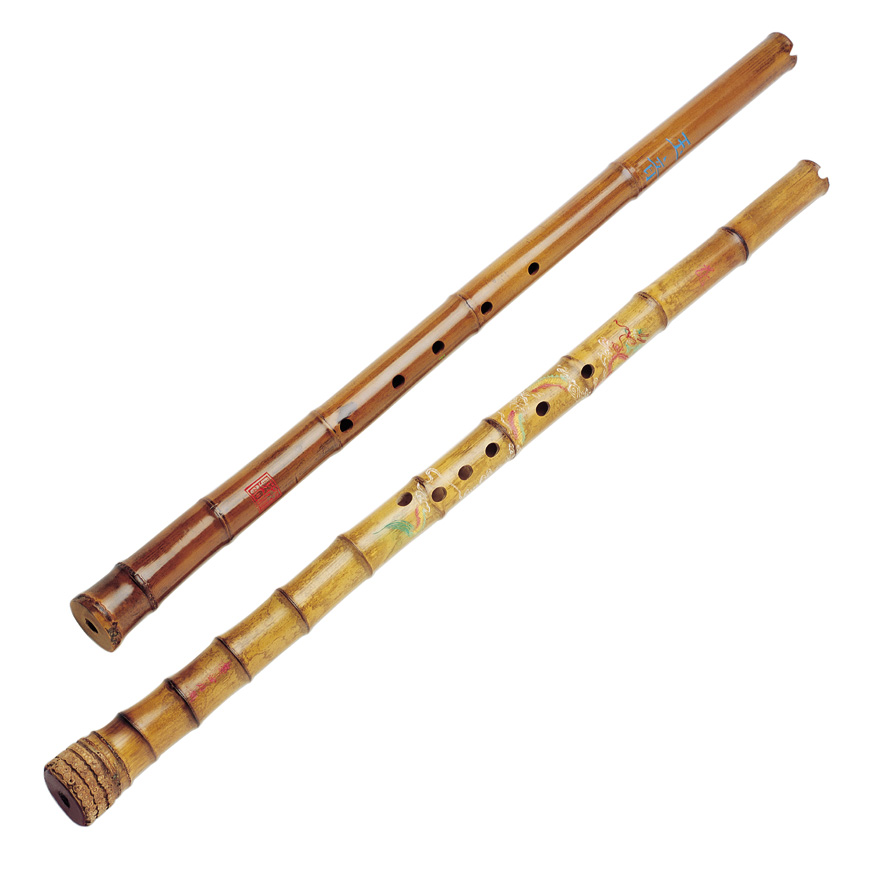
現在的簫在漢魏六朝時代稱為篴(di即笛)。篴從我國西北羌族地區傳到中原地區,最初只有四個按孔,西漢京房(公元前七七年至前三七年)在背面加一孔,才有了五個按孔。晉代樂工列和在西元二四七年左右所吹的笛(簫),已有六個按孔,與今天的簫差不多。
唐代有一種稱為尺八的吹管樂器,形制與今天的簫相似,但另加有貼竹膜的孔。唐宋以來,漸將篴改稱為簫或洞簫。
簫在魏晉南北朝時,已用於伴奏、合奏和獨奏。晉桓伊曾在笛(簫)上作三弄調;在魏晉南北朝伴奏相和歌的樂隊中,都用到笛(簫)。現在的簫仍用於伴奏、合奏和獨奏。
簫,竹製,直吹,按孔為前五後一,上端開一吹口孔。音色圓潤、柔和。
Xiao was the wind instrument of China. It was first appeared in Han dynasty and was called di. Di was spread by the Jiang tribe from the north-west to the central area of China. It originally had only four holes. Jing Fang of Han dynasty added one hole at the back of it and became a five holes instrument. Lie He of Jin dynasty made it to a six-hole one and almost the same as today’s instrument. In Tang dynasty, there was a wind instrument called Shakuhachi which was similar to the xiao of today. It has a hole for the bamboo membrane sticker. Since Tang dynasty, di was steadily changed the name to xiao or dongxiao. The instrument is made of bamboo with five holes in the front and one hole in the back. It was blowing vertically at the upper end to produce a soft musical sound.
骨哨與骨笛
Gushao (Bone Whistle)
Gudi (Bone Flute)
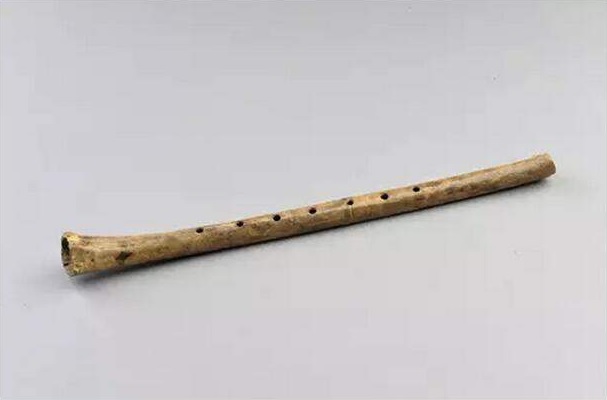
一九七三年浙江餘姚市河姆渡遺址出土了一百六十件骨哨和骨笛,據測定是屬新石器時代遺物,距今已有約七千年左右的歷史。河姆渡的骨哨用禽鳥的肢骨中段製成,長約六至十釐米不等,中空,器身略有弧度在凸弧一側磨有一至三個圓形或橢圓形孔,有的在一側兩端各穿一個孔,也有一邊堵塞,一邊是窯,二頭空叫哨,一頭堵住的叫笛,骨哨與骨笛的區別在此。河姆渡骨哨和骨笛仍可吹出簡單的音調,聲音尖稅,與鳥鳴聲相像。可能是先民們利用骨哨發出的鳥鳴聲誘捕各種飛禽,或發出簡單的聲音訊號,其中一支結構像兒童們玩的豎笛。骨哨與骨笛不僅是笛子的鼻祖,而且是迄今為止在我國發現的年代最久的樂器。
–Gushao (Bone Whistle) and Gudi (Bone Flute)
In 1973, a hundred and sixty pieces of bone shao (whistles) and dizi were unearthed at Hemudu Site in the city of Yuyao of Zhejiang province. The bone relics, according to the science reports, were the remains of the New Stone Age, roughly 7000 years ago. Bone whistles at Hemudu Site are made of the mid-sections of bird limbs, of varying lengths ranging from six to ten centimeters. Shao are made of bones hollowed out, with one to three circular or oval holes on the convex surface of it. Some have two holes made at one end, while others have holes on both, which is how a shao differs from a di. Gushao has holes at one end while gudi has holes at both ends. The bone whistles and flutes excavated at Hemudu are capable of producing simple, high-pitched sounds like the birds. The primitives may have used them to catch game, or sent out messages. One of these pieces resembles the kind of flute children play today. Gushao and gudi are not only the prototypes of flutes, but also the earliest musical instruments hitherto unearthed in the country.
排簫 - Paixiaio
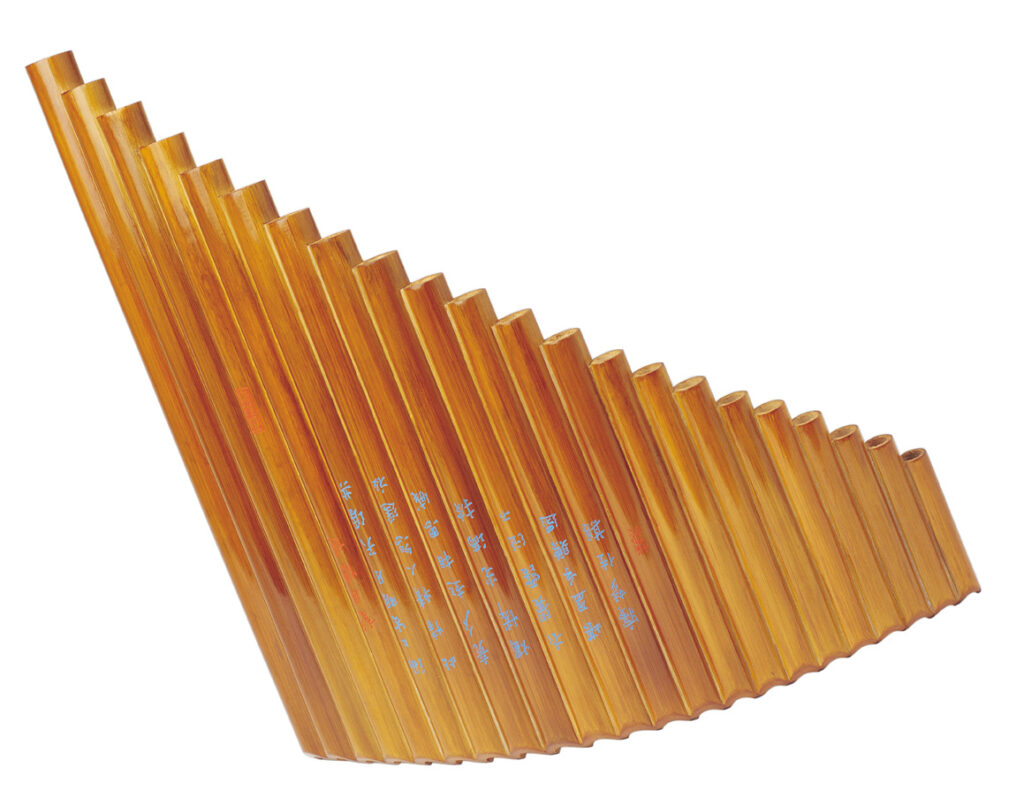
排簫,古代吹奏樂器。原稱簫。《世本》:「簫,舜所造。其形參差象鳳翼,十管,長二尺。」;《博雅》:「簫,大者二十四管,無底;小者十六管,有底。」;《三禮圖》:「無底者謂之洞簫」。漢、唐以來石刻、壁畫及隨葬陶俑中常可見到吹奏排簫的形象。宋以後民間失傳,只用於宮廷雅樂。湖北隨縣曾侯乙墓出土有排簫,竹製、編管十三,按長短依次排列,最長者二十二點五釐米,最短者五點一釐米,用三道篾篐束結,是目前考古發現年代最早的實物。近人從甲骨文侖字的形態,認為侖或籥,是一種編管樂器,接近排簫的原始形制。
–Paixiao
Paixiaio was a kind of ancient wind instrument of China. It was originally called xiao. The old history book mentioned that it was made by emperor Shun according to the shade of the phoenix’s wing. The instrument had ten tubes in two rulers’ length. Another ancient record mentioned that the bigger xiao had twenty-four tubes in free end and the smaller one had sixteen tubes with a closed end. Other book defined that the free-ended one was call dongxiao. We can always find the performing figures of paixiao from the rock carvings, paintings and pottery of Han and Tang dynasty. After the Song dynasty, paixiao had disappeared in the nongovernmental activity, it was only used at the court. In Sui county of Hebei province, there unearthed a bamboo paixiao with thirteen tubes setting order according to the tubes’ length. The longest one was 22.5 cm and the shortest one was 5.1 cm bound together by three bamboo strips. This was the oldest archaeological discoveries of paixiao.
葫蘆絲 - Hulusi
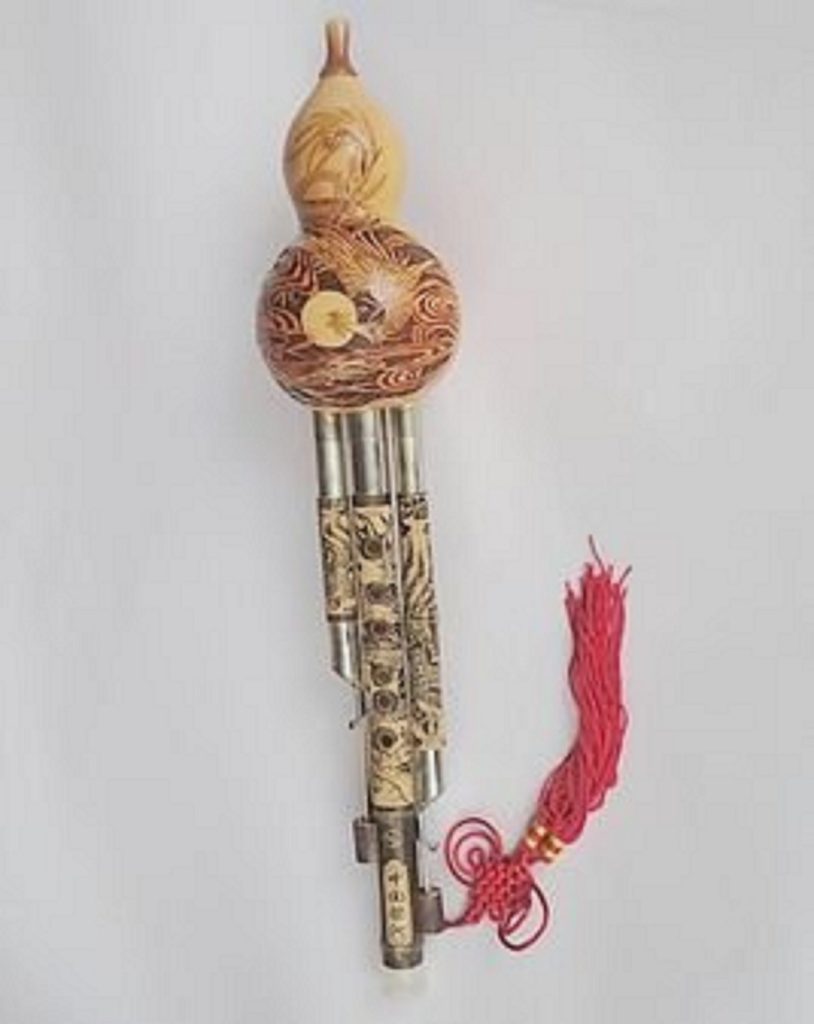
葫蘆絲,是流行於傣、彝、阿昌等民族的樂器。這種樂器用半截小葫蘆作為音箱,以三根長短不一的竹管並排插在葫蘆內,插入葫蘆的竹管下端,嵌有銅質簧片,中間較長的一根竹管開七孔(前六後一)。
吹奏時,口吹葫蘆細端,指按中間竹管的音孔,在奏出旋律的同時,左右兩根竹管同時發出固定的單音,與旋律構成和音。葫蘆絲音色柔和,常用於獨奏和合奏。
Hulusi was a popular musical wind instrument of Dai, Yi and A-Chang tribes. The sound box is made of a dried fruit called hulu. There are three bamboo tubes with brass reeds in different length inserted. The longest one has opened six holes in the front and one hole in the back of it. By blowing the small end of the hulu and pressing the holes of the bamboo tube, we may produce beautiful musical sounds. The other bamboo tubes can also produce two sounds for harmony. It is commonly used as solo instrument and in ensemble works.
嗩呐 - Suona
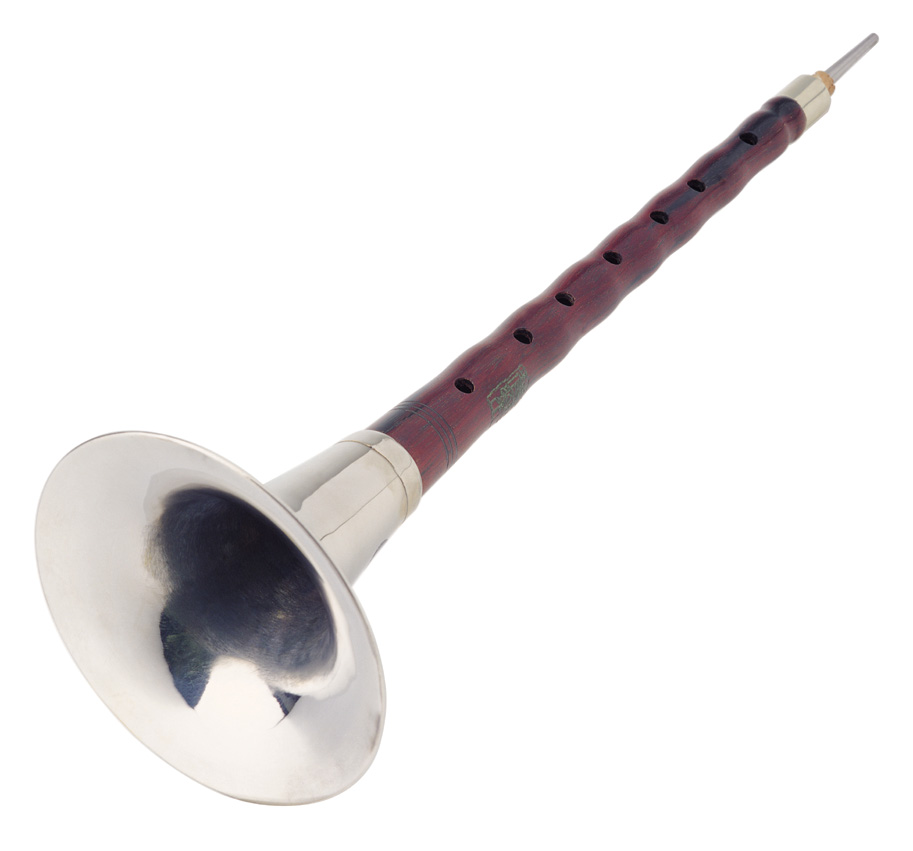
嗩呐又名喇叭,小嗩呐又稱為海笛。兩晉時期(公元二六五至四二○年)已流行於新疆地區。清代嗩呐在回部樂中使用,稱為蘇爾奈。它是民間運用最廣泛的樂器之一,除了用於合奏、獨奏外,也用於戲曲、歌舞等伴奏。在民間,每逢喜慶節日,吹打和鑼鼓樂隊中大都離不開嗩呐。
嗩呐,在木製的錐形管子上開八孔(前七後一),木管上端裝一銅管,銅管上端套一葦製哨子,木管下端接一喇叭形銅質擴音器。音色高亢明亮,有的民間藝人能控制氣息,吹出柔美的簫音。
經過改革的嗩呐有高、中、低三種,有的還加了音鍵,擴大了音域。
Suona is also called the trumpet. The smaller suona is called haidi. Since Jin dynasty, it was widely spread in Xinjiang. In Qing dynasty, it was called suernai. It was the most widely used musical instrument. Apart from the ensemble and solo, it was also be used in accompaniment of opera and dance. During the festival days, it was used together with other wind instruments and the percussions. The instrument has a conical tube with seven holes in the front and one in the back. At the small upper part, there is a brass system with a reed whistle. While at the bigger lower part is installed with a brass loudspeaker. Its sound is bright and some artists can control it to produce soft sound like the xiao. The suona has been reformed to consist of high, medium and low pitch series with difference keys.
管 - Guanzi
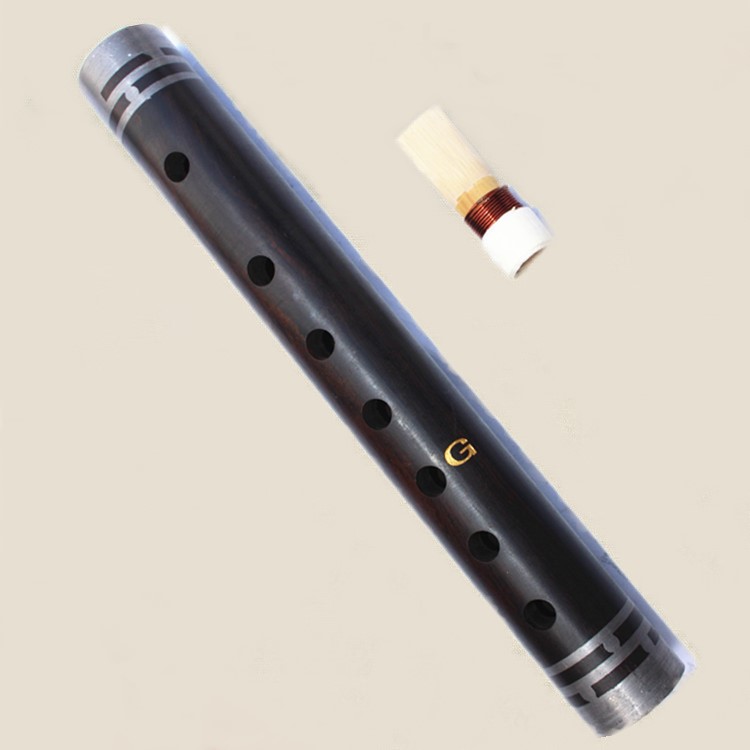
管,流行於我國北方。古稱篳篥(bi li)或觱篥。北魏雲崗石窟(公元四六○至四九四年)雕刻中已有管。隋唐九、十部樂中,有好幾部用到篳篥。北宋教坊十三部中有篳篥部。
管,木製,上開八孔(前七後一)。管口插一葦製的哨子。管的音色高亢。在北方管樂隊中常常用以領奏。
新中國成立後,管的製造和吹奏技術都有了發展。經過改革的管,音域擴展為二組又六個音,加鍵管能演奏十二個半音,在合奏和獨奏中發揮更大的效能。目前在樂隊中經常使用的有中音管、低音管和加鍵管。
Guanzi is spread popularly in the northern part of China. In ancient time, it was called bi li. In the Yungang Stone Grottoes of Northern Wei dynasty, there were carved with guanzi. Many ensembles of Sui and Tang dynasty used guanzi as their main instruments. In Song dynasty, the music training department also included bi li in their project. The instrument was made by using a wooden tube as sound box, which had seven holes in the front and one in the back. It was performed vertically by blowing the reed whistle at the upper end. The sound of it is bright and always be used as leading instrument in the northern ensembles. Nowadays, guanzi has developed to have wider range and can play semitones.
雙管 - Shuangguan
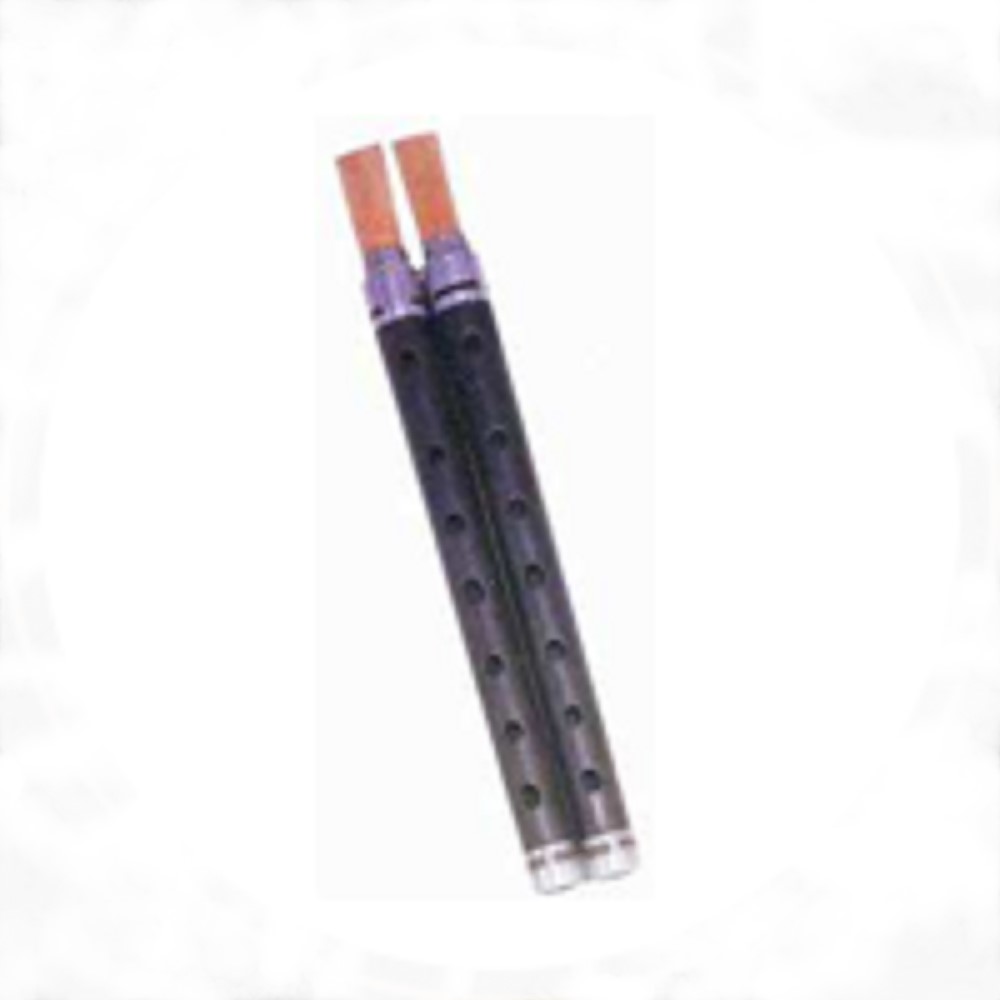
雙管,系將兩支管並排紮結一起吹奏,流行於東北、華北廣大地區,多用於獨奏、合奏。
東漢鄭玄注《周禮‧春官‧小師》:「管如篴而小,並兩而吹之」。可見當時已存在雙管類樂器。《隋書‧音樂志》載龜茲樂中有雙篳篥。新疆吐魯番東北部的伯孜克里克石窟(開鑿於五五○至一三六八年)第二十九窟有雙篳篥圖像,雙管並列,管身有五個按孔。宋陳暘《樂書》中載有雙篳篥:「胡部安國樂器有雙篳篥,《唐樂圖》所傳也」。
又有雙鳳管:「雙鳳管合兩管以足十二律之音,管端施回簧,刻鳳以為首,左右各四竅」。表明雙管自唐以來已廣為應用。
現代雙管由兩支長短、音高相同的管子並排紮結而成。每管八孔(前七後一)。九孔管已很少見到。演奏時,可以兩管並吹,也可將兩管分開,兩手各持一管,手指各按管子上方的三個音孔,交替吹奏短促的音符,以烘托氣氛,把樂曲推向高潮,代表性樂曲有《江河水》等。
Shuangguan is binded with two guanzi side-by-side. It is always be used in the northern part of China for solo and the ensemble. ZHENG Xuan of Han dynasty mentioned on his book an instrument some what like Shuangguan. In the music volume of Sui dynasty, there were double bi li. There was a double five-hole bi li carved in the Stone Grotto of Bazi Kerik in Xinjiang. CHEN Yang of Song dynasty, had described in his Book of Music about the double bi li. In Tang dynasty, there was a widely used instrument called double phoenixes guan. It was so called because there were carved with a phoenix on each end of the two pipes. These two pipes together can play twelve semitones. Nowadays, the shuangguan is an instrument by binding with two guanzi of the same length and pitch together. Each guanzi has seven holes in the front and one in the back. During performance, the performer can play two guanzi together or separately by using three fingers pressing the upper three holes to perform short notes. The representative music of shuangguan is River Water.
喉管 - Houguan
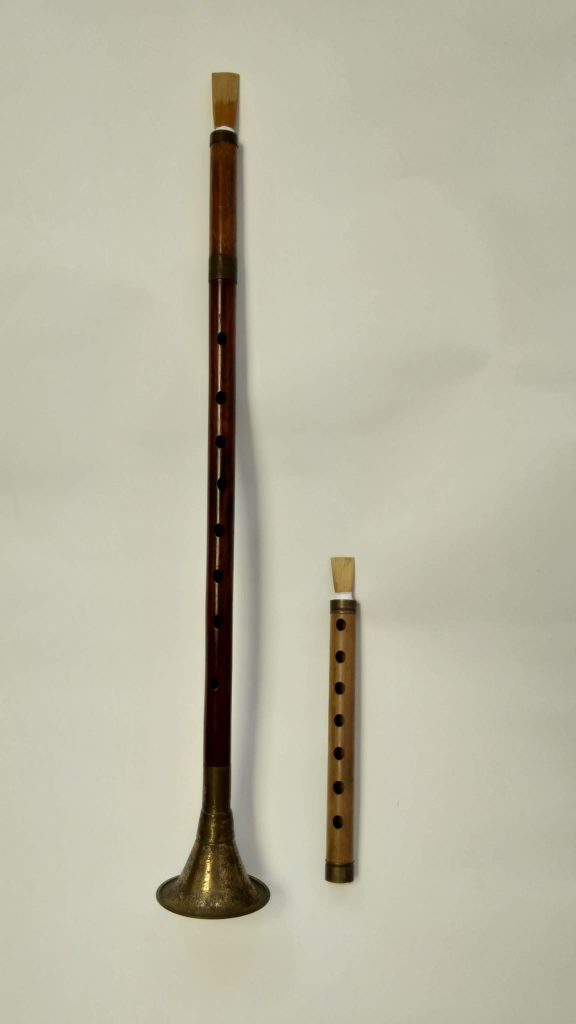
喉管,又稱竹管,短小的稱為「短管」,長而低音的並於管身下端加碗者稱為「沉筒」。本世紀二十年代末用於演奏廣東音樂和粵劇伴奏,後流行兩廣地區。五十年代初,又發展出中音和低音喉管。
喉管由哨、管身和喇叭口構成。哨蘆葦製,兩片相對合成,哨口較寬而哨片較厚。管身用長莖竹、紅木、塑膠管或金屬管制成,上開七孔,音色各異,以竹製為佳。管下端裝銅製喇叭口。低音喉管還設銅製曲頸。中音喉管全長約五十三、內徑一至一點三釐米;低音喉管全長約八十五、內徑一點四至一點七釐米。
民族樂隊常用G調中音喉管和D調低音喉管。不能超吹。音域分別為d-d1和A-a。通過控制哨子,可轉近關係調。喉管發音接近管的低音區,在樂隊中常與中胡或低胡結合使用,以加強中、低音聲部。多用單吐法,可奏滑音、疊音、花舌和顫音等。
二十世紀六十年代出現加鍵喉管。管身加裝按鍵,開十八或十九個按音孔,設一個泛音孔,可以超吹(如筒音g,超吹發高十二度的d2)、演奏半音階,適於轉調。音域兩個半八度,可用於獨奏。
Houguan is also called bamboo pipe. The shorter one in high pitch is known as duanguan. While the longer one with a brass loudspeaker at the lower end and in low pitch is known as chentong. In the late of 1920s, it was used for performing Guangdong music and accompaniment of Guangdong opera. It was later widely spread in Guangdong and Guangxi. In the early 1950s, it was developed to have alto and bass houguan. The instrument is consisted of the whistle, the pipe and the loudspeaker. The whistle is made of reeds. The pipe is either made of bamboo, hard wood, plastic or metal. It is opened with seven holes and can produce different sound quality according to the substance of the pipe. It is the best of the bamboo ones. For chentong, it has a brass made loudspeaker at the lower end to enlarge the sound produced. In the traditional orchestra, it is always used the G alto houguan and the D bass houguan. The range is set at d-d1 and A-a. By controlling the whistle, it can change the melody to relative tones. Houguan produce sound of bass like the guanzi and always be used together with zhonghu in the ensemble. After 1960s, It is developed to install mechanical system to wider the performance techniques and range. It can play semitones of two and a halve octaves. It is now developed to a solo instrument.
口笛 - Koudi
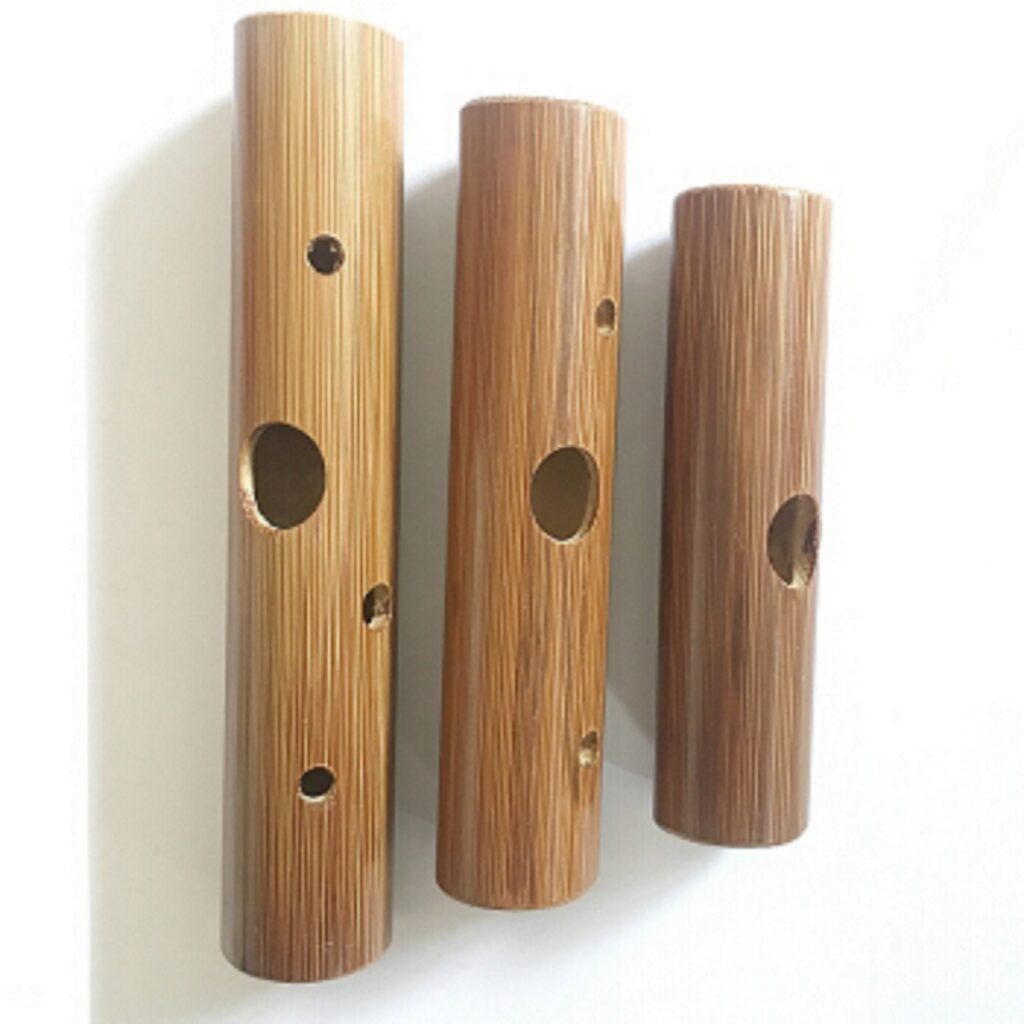
口笛,上海民族樂團俞遜發創製的新型吹奏樂器。
用黃枯竹或小水竹製作,也可用長莖竹、鳳眼竹或紫竹。在一段短而細的竹管上,中間開一吹孔,利用管端的自然孔,成為兩孔口笛,若在近吹孔處再開三個音孔,稱為五孔口笛。
演奏口笛,左、右手拇指控制第二、一孔,左手食指按第三孔,右手中、食指按第四、五孔。音孔全按發出最低音,開一孔發上方純四度音,開一、二孔為純八度音,兩拇指在音孔上移動,多開或少開一點音孔,一、二孔可分別發出四度以內音階。
口笛發音近似哨音,音量較大,穿透力強。可演奏歡快、優美的旋律,模仿百鳥爭鳴和接近人聲的唱腔。獨奏曲有《苗嶺的早晨》、《雲雀》和改編的《陽光照耀著塔什庫爾幹》等。
Koudi is a newly invented wind instrument by YU Xun-fa of the Shanghai Chinese Orchestra. It is made from a small portion of bamboo tube with a blowing hole opened in the middle. By using the natural ends of the tube to perform is the two-hole koudi. If we open three more holes near the blowing hole, it is the five-hole koudi. When performing, the second and the first hole are controlled by the left and right thumbs. The third hole is controlled by the left index finger. While the fourth and the fifth holes are controlled by the right middle and index fingers. The lowest note can be produced by closing all five holes. The sound it produced is some what like the whistle. It has high frequency and volume. Its tone colour possesses a strong penetrative quality. It can play beautiful melodies and imitation of bird-calls. The solo pieces for koudi include Morning at Mount Miao, The Lark and the adaptation of Sunshine on Taxkorgan.
巴烏 - Ba-u

巴烏,雲南省彝、苗、哈尼等少數民族使用的單簧吹管樂器。
巴烏用竹管製成,有八個按孔(前七後一),吹口處裝一尖舌形銅質簧片。演奏時橫吹上端,振動簧片發聲。巴烏音量較小,音域較窄,但音色柔美。常用於伴奏舞蹈、說唱,也能獨奏。近年來,對巴烏進行了改革。改革後的巴烏管身略粗,加四個鍵子,音域有所擴大,音量增加。
Ba-u is a single reed wind instrument of minorities Yi, Miao and Hani in Yunnan. The instrument is made of bamboo tube with seven holes opened in the front and one in the back. There is another blowing hole installed with a brass reed. It is performed horizontally by blowing the brass reed and pressing the other holes to produce musical sounds. The sound it produce is small, soft and beautiful, but the range is narrow. It is always used for the accompaniment of dance and sing, sometimes used for solo. In recent years, it has been reformed to have wider range and volume.
塤 - Xun
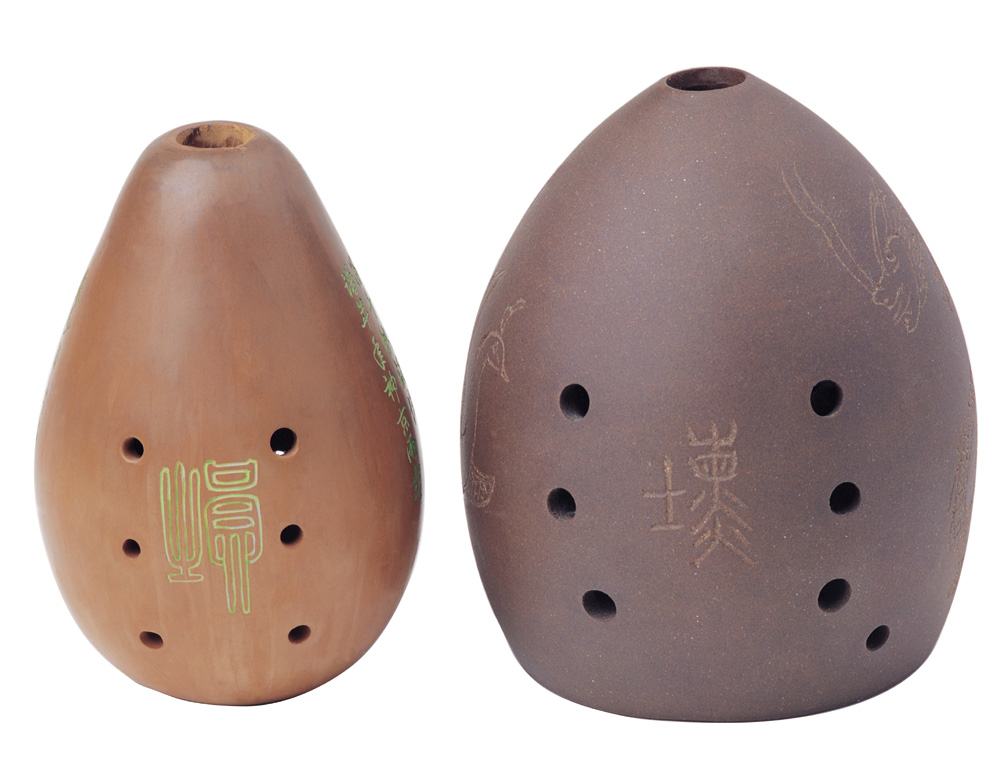
塤是一種用陶土燒製的樂器,同其他樂器一樣,它是伴隨著勞動而產生發展的,塤的歷史可以追溯到新石器時期。
我國發現最古老的塤,一個是七千年前我國浙江杭州灣河姆渡原始居民使用的一孔塤,另外兩個是在我國西安半坡村母系社會遺址出土的。
塤這種樂器還在我國山西、甘肅、河南、山東省等地出土過。從出土文物看,塤經歷了漫長的發展階段。古代塤的樣子很多,有梨形、魚形、球形和筆管形等,製作塤的材料有陶、石、玉、木、象牙等,後來多是陶製的。
今天,塤重獲新生,應當歸功於那些熱心於挖掘、研製、改革、創新的民族音樂家和演奏家,在他們的艱苦努力下,塤的音域不斷擴展,已由過去的六個音孔增加到十幾個音孔,能夠順利地奏出十二平均律,塤的表現力得到了極大地豐富,塤的演奏技巧的不斷創新,作品的不斷湧現,使塤這一古老的樂器又重新煥發了青春。如今的塤不僅能吹出古雅深沉、如泣如訴的悲涼旋律,而且能奏出熱情奔放、詼諧幽默的歡樂樂章。
Xun is a wind instrument made of pottery. Its development was engaged to the manual labour in the early times. Its history can be traced back to the Neolithic period. One of the oldest xun of 7000 years before was unearthed in Hemudu of Zhejiang province. This was a single hole xun. Another two were unearthed in Banpo village of Xi’an. Xun were also unearthed in Shanxi, Gansu, Henan and Shandong provinces. It had undergone a long period of development and had different shapes like pear, fish, spherical and tubular. The manufacturing material included pottery, stone, jade, wood and ivory. But the most common one is earthenware. Today, we can easily approach the xun must attribute to those musicians and instrumentalists who are hard working in unearth, research, reform and bring forth new ideas. They have developed it to an over ten holes instrument and can play semitones. Today, xun is not only to play ancient melodies, it can also play melodies of warm, flowing, joy and with humor.

